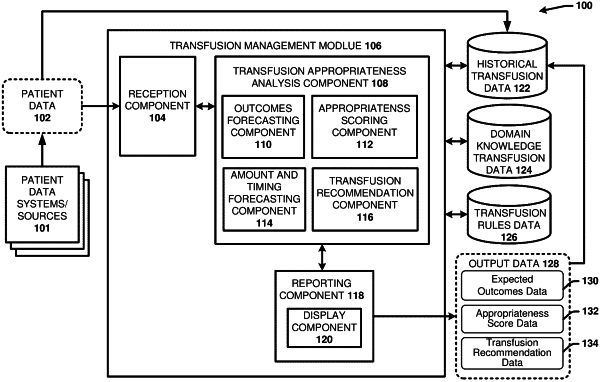| CPC G16H 50/20 (2018.01) [G06N 5/04 (2013.01); G06N 20/00 (2019.01); G16H 10/60 (2018.01); G16H 15/00 (2018.01); G16H 20/17 (2018.01); G16H 40/20 (2018.01); G16H 50/70 (2018.01); A61M 1/02 (2013.01)] | 19 Claims |

|
1. A system, comprising:
a memory that stores computer executable components;
a processor that executes computer executable components stored in the memory, wherein the computer executable components comprise:
a tracking component that tracks transfusion procedure information for patients that received transfusion procedures, the transfusion procedure information comprising post-transfusion clinical response data for the patients and appropriateness scores that represent a level of appropriateness of the transfusion procedures for the patients, the appropriateness scores determined using one or more machine learning models trained to forecast the appropriateness scores based on forecasted outcomes of the transfusion procedures;
a performance evaluation component that evaluates appropriateness of the transfusion procedures across different verticals based on the appropriateness scores and generates corresponding reports;
a transfusion management application that provides access to the transfusion procedure information and the corresponding reports via an interactive dashboard user interface;
a model updating component that employs one or more machine learning techniques to update the one or more machine learning models based on learned imbalances between the appropriateness scores and the post-transfusion clinical response data using the corresponding reports, resulting in updated versions of the one or more machine learning models with improved clinical accuracy; and
a waste management component that:
identifies a medical provider that consistently performs inappropriate transfusion procedures included amongst the transfusion procedures for a subset of the patients that received an appropriateness score indicating performance of a transfusion procedure was inappropriate; and
based on the identification, monitors new appropriateness scores generated via the one or more machine learning models for new patients associated with the medical care provider.
|